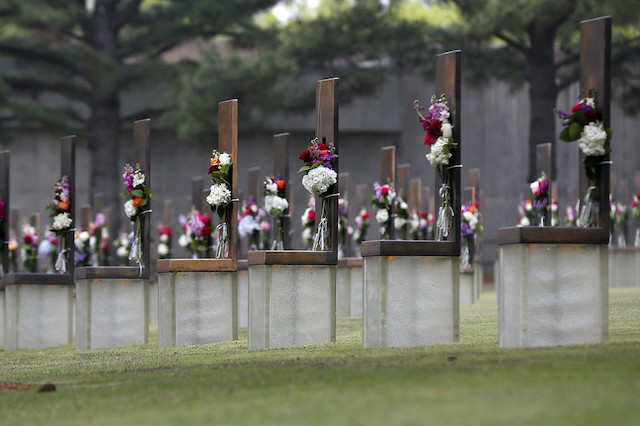Trucking in Fear: Rental Trucks as a Terror Tactic
| by Amy Cooter
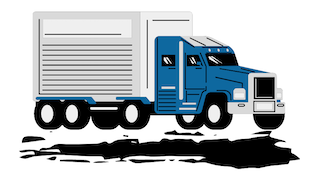
In 1995, military veteran Timothy McVeigh shocked Americans’ collective conscience by conducting what was, at the time, the largest terror attack on US soil. He murdered 168 people in Oklahoma City at the Alfred P. Murrah Federal Building and injured hundreds more. Many of his victims were children whose parents had entrusted them to a daycare center inside the building that otherwise housed federal agents and other government offices.
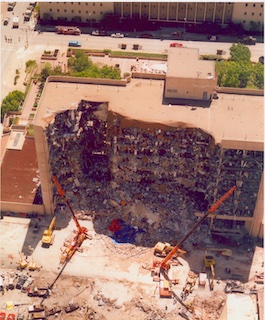
One of the many elements that stood out to both the general public and to law enforcement about this terrorism was McVeigh’s use of a Ryder truck to transport and park a homemade fertilizer bomb close enough to the building to ensure its destruction. McVeigh’s actions were inspired by The Turner Diaries, a racist call to arms guised as a novel whose narrative includes a bomb similarly concealed in a borrowed delivery truck that is used to kill FBI agents. McVeigh may have also known that Ryder had also been the conveyance of choice for the earlier 1983 World Trade Center bombing that had killed six people.
There is something frightening about terrorists strategically using an otherwise-benign tool to intentionally inflict harm, about the idea that a weapon of such potential harm could be concealed inside something so common as a moving truck–something most Americans may use many times throughout their lives. In the US, unrestricted interstate travel is framed as part of citizens’ birthright, an extension of the mythology of our frontier past. The thought that any fellow traveler might be plotting to violently undermine our collective freedom and safety—the very pillars of that myth’s promise–via an instrument of daily life–is especially alarming. It may also be a more pernicious indicator of the broader decline in public trust and perceived cultural cohesion in America.
A year after the Oklahoma City bombing, Ryder rebranded, replacing their distinctive yellow trucks with a more muted scheme, predominantly white, with red and black lettering. Ryder secured news coverage from the New York Times and financial outlets that presented this rebrand as resulting from a sale and an internal restructuring focusing commercial services. This new coverage doesn’t mention the bombing, and, elsewhere, Ryder’s spokesman insisted the bombing was not “an image problem,” going so far as to say he was thankful the World Trade Center bombers had used his company as he credited his company’s computer system with being able to quickly identify the perpetrators. Yet, it is difficult to imagine there were no in-house conversations about the need to distance the company, visually and otherwise, from the terrorists who had successfully used its trucks in deadly attacks against American civilians. In more recent years, Ryder’s connection to the attack has nonetheless lived on in memes popular among far-right users, especially in Telegram’s Terrorgram ecosystem, that praise McVeigh’s destruction with varying degrees of conspicuousness.
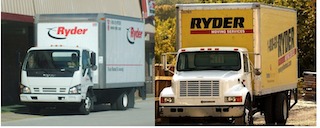
Other extremists have continued to use rented trucks for nefarious aims. More recently, the trucks’ cargo has not been bombs, but rather human instigators. In early December 2021, dozens of white nationalist Patriot Front (PF) members demonstrated on the National Mall in Washington, DC. It wasn’t their first attempt to spread hate in the nation’s Capital, but it was the first time that they received extensive mockery for their use of a U-Haul truck to clandestinely transport their members. Videos on Twitter memorialize members leaving their demonstration by packing into the back of a truck too small to hold all of them simultaneously. Members waited out in chilly weather for the truck to make multiple return trips so they could all leave the site as police and bystanders watched. Ultimately, PF members’ lack of advance coordination and their subdued shivering in the dark retrospectively undercut the intimidation efforts that they had intended in their unsynchronized marching and scattered chants to “reclaim America.”
PF members had used a similar tactical withdrawal five months earlier, relying that time on a small fleet of Penske trucks in a more coordinated escape after a flash-mob-style demonstration in Philadelphia about immigration and a supposedly-stolen election. Video shows them ineffectually retreating from Nazi-intolerant Americans while holding what one Twitter user derided as “Toys-R-Us shields.” Penske rapidly released a social media statement condemning PF’s use of their trucks and saying they would ‘take action” against the people who had rented the trucks, which presumably meant they would ban future business from the renters.
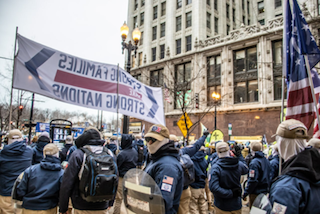
That minor prohibition, alone, is unlikely to have been the impetus for PF’s seeming shift to preferring U-Haul as their weapon of mass transportation but was still an important message to send. In 2024, we do, unfortunately, need to vociferously disavow Naziism. It appears, however, that U-Haul’s response has been rather tepid. After someone drove around Des Moines with a large swastika flag on a truck in 2022, a spokesperson for the company noted the action was a “breach of contract” and that they would no longer do business with the driver. If U-Haul has made other statements about PF’s repeated use of their vehicles, those statements are not easy to find.
Thirty-one PF members with gear including riot shields and a smoke bomb were arrested in Idaho in June 2022, on suspicion of conspiracy to riot while en route to a Pride event. Only five of those arrested eventually faced minimal sentences, but most of them continued to face ridicule for quite some time after being filmed while being taken into police custody. It’s difficult, after all, to maintain the image of an ubermensch when awkwardly stepping down from a box truck, face covered and hands raised in surrender—uncomfortably in front of your chest, no less, because the cramped space makes it impossible to properly raise your arms.
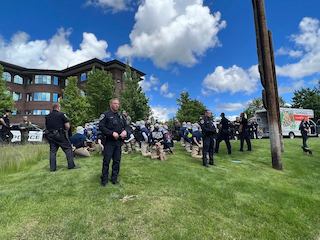
Last weekend, U-Haul was once again linked to racial hatred when members of a different, but similarly odious, Nazi group called Blood Tribe marched in Nashville, Tennessee. Footage of them bellowing at each other from inside one of the company’s trucks circulated online shortly after they marched in front of the downtown courthouse, as did footage of bystanders rejecting their message.
Whataboutists consistently demand extremism researchers answer questions about Nazis’ supposed counterparts’ parallel use of violence or other tactics, so it is worth mentioning that rental trucks have also been used in recent demonstrations by people whose impetus is something other than culturally foisting us all back in time. Police in Kenosha, Wisconsin also refused to allow a U-Haul with Gatorade and other supplies to reach protestors who were demonstrating against the police shooting of Jacob Blake in September 2020. The supplies had been sent by a church who rejected the police report that there had been items “consistent with rioting” in the truck. No charges were filed around the incident, and it appears that Kenosha police released no further clarifications about this allegation.
Later that same month, rumors and conspiracy theories flew around certain corners of the internet that Antifa was using U-Haul to deliver weapons to Black Lives Matter protestors in Louisville, Kentucky following the murder of Breonna Taylor. Video that some of the alarmists themselves recorded indeed showed a U-Haul truck with supplies being unloaded, but there were no weapons. Instead, banners, other signage (some of which included antifa imagery) and shields constituted the delivery. The specter of weaponry being contained in the delivery seemed to be driven by racial threat. It was also an extension of the conspiracy theories in preceding months spouted by people who, apparently, had never previously visited cities before and insisted that stores of bricks mysteriously “appeared” overnight, supposedly to facilitate violence from Black Lives Matter supporters.
PF, too, used a U-Haul for carrying only equipment on at least one notable occasion. Three men driving a truck with shields, flags, and other supplies were stopped and recorded by police as they left a demonstration in Boston in July 2023. The other hundred or so members in Boston were left (rather ironically, given the group’s disdain for anything resembling socialism) reliant on the T’s public transportation to leave the city. Videos of them waiting for their train while being confronted by a few onlookers show many PF members with crossed arms, avoiding any eye contact with the camera even behind dark glasses, and generally signaling nervous and uncertain body language.
There are undoubtedly practical reasons for using rental trucks for pop-up intimidation. We know that many of the above demonstrations have involved members from several different states; at least eleven home states were revealed for the Idaho arrestees, for example. Members presumably travel to a hotel or some other meeting location near their planned site, then huddle together in the last few miles preceding their actions. Driving a single vehicle to the main protest point limits the use of personal vehicles that would increase identification of individual members, something clearly attractive to the individuals who cover their faces with white gaiters or black ski masks, sunglasses, and ball caps, refusing to own their own hate.
Rental trucks are easy to obtain. Any 18-year-old with a government ID and a credit card can acquire one, and usually for a minimal daily fee. Renters aren’t asked questions about their plans for using the trucks and would be unlikely to answer truthfully if they intended harm. Trucks are larger than more conventional passenger transportation options, certainly large enough to facilitate the appearance of strength in numbers when traveling to or from collective action, with more maneuverability and accessibility than would be provided by a passenger bus.
Extremists may also fantasize about the possibility of using the trucks’ laden mass either defensively or offensively should they decide to balk at police intervention or target counter protestors, especially since several states have, in recent years, reduced penalties for drivers who hit pedestrian protestors. Trucks have been weaponized in this way in other attacks, including one driver’s flimsy effort to “overthrow the government” by crashing a U-Haul into barriers around the White House in May 2023, and pulling a Nazi flag out of the cargo area after the collision.
Rental trucks also have some obvious drawbacks for human delivery, however. Most trucks do not come equipped with lighting or seating in the cargo area, gifting us with those viral images of wobbly Nazis stumbling out of the back while blinking at the sun. The lack of seatbelts has not thus far led to stops for low-hanging traffic violations that could derail some of their plans, but might pose a small barrier to their coordination in future events.
We don’t want to falsely inflate the importance of rental trucks—U-Haul or otherwise—in the overall extremist landscape. While they will undoubtedly continue to be used for a variety of nefarious purposes, especially if condemnation from the company is lacking, it is unlikely that most of those trucks harbor something sinister. Peaceful protestors and law enforcement officers would nonetheless likely benefit from exercising caution if out-of-place rental trucks arrive unannounced to ongoing demonstrations or to city centers and important buildings.
What we most want to remember, however, is this: While the goal of these sporadic intimidation efforts that are facilitated by rental trucks is to instill fear and to discourage civic participation, it is truly the supremacists who are afraid. They’re afraid of social change, of losing perceived power. They’re also afraid to own those feelings. They hide their identities, afraid of social condemnation, of losing their jobs, or of possible criminal consequences. They sometimes travel long distances to demonstrate outside of their hometowns, afraid of being more easily recognized in their own backyards. They want you to forget their fear, to forget that most of us are not motivated by hatred, and to forget that speaking up and showing up is necessary to maintain our democracy.
What we most want to remember, however, is this: While the goal of these sporadic intimidation efforts that are facilitated by rental trucks is to instill fear and to discourage civic participation, it is truly the supremacists who are afraid.
